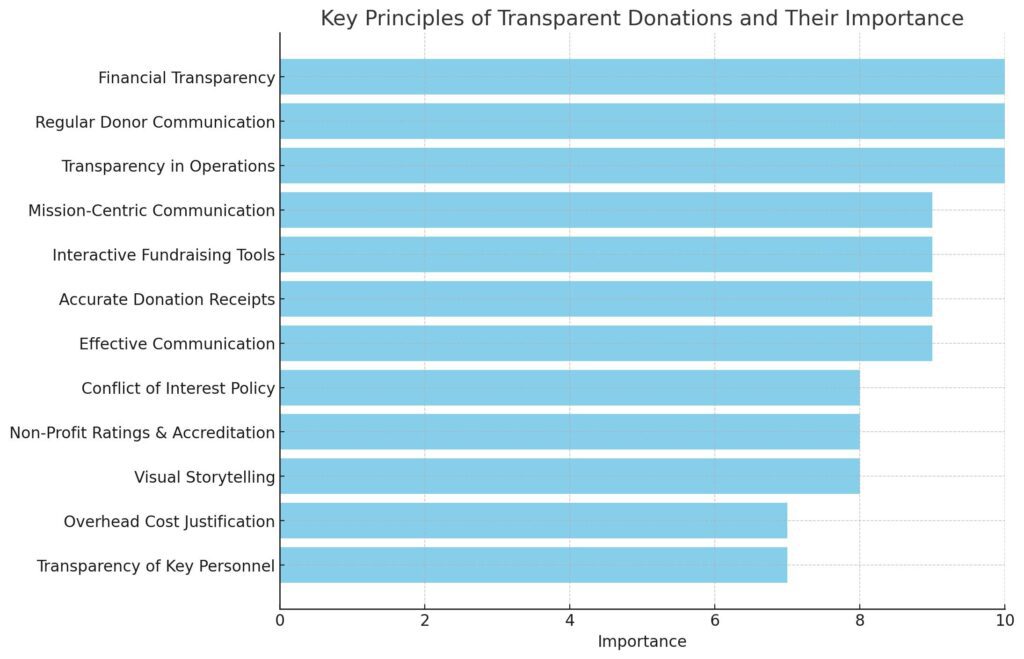Key Principles of Transparent Donations: Building Trust and Effectiveness in Non-Profit Organizations
Key Takeaways
| Principle | Description |
|---|---|
| Transparency in Operations | Open communication about the organization’s goals and operations, engaging donors effectively. |
| Effective Communication | Clear, honest communication to address donor concerns and update on fund usage and impacts. |
| Accurate Donation Receipts | Providing detailed and timely receipts to donors, reinforcing trust and accountability. |
| Real-time Tracking and Alerts | Utilizing tools for transparency in fund allocation and usage, keeping donors informed. |
Transparency in non-profit organizations is not just a buzzword; it’s a critical pillar of trust and effectiveness. In a world where donors are increasingly vigilant about how their contributions are used, transparent practices stand out as a beacon of integrity and accountability. At the forefront of promoting transparency is DonationTransparency.org, a platform dedicated to ensuring that non-profits uphold the highest standards of openness in their operations.
The Essence of Transparency in Non-Profit Operations
Transparency for non-profits means being an open book: from the clarity of mission statements to the intricacies of fund allocation. It’s about letting the public and donors peek behind the curtain to understand the organization’s goals and operational methodologies. This openness is not just about building trust; it’s about engaging donors in a meaningful way, transforming them from passive contributors to active participants in the cause. The platform at DonationTransparency.org facilitates this by offering tools for real-time tracking and personalized alerts, ensuring that donors are not just informed, but also engaged.
Effective Communication: The Core of Transparency
At the heart of transparency lies effective communication. It’s about more than just sharing information; it’s about ensuring that the message is clear, honest, and resonant with the audience. Non-profits must address donor concerns proactively, squashing doubts with facts and figures, and sharing successes and challenges with equal candor. Donation Transparency aids in this by providing features like real-time tracking and alerts, making sure that the communication bridge between donors and organizations is not just intact but thriving.
Accurate Donation Receipts: A Pillar of Trust
Reliable donation receipts play a pivotal role in maintaining transparency. They are not just records; they are tokens of trust, assuring donors that their contributions are acknowledged, accounted for, and appreciated. With Donation Transparency, the process of issuing accurate and timely receipts is streamlined, ensuring donors receive immediate confirmation of their contributions, adding to the layers of trust.
Visual Storytelling and Impact Reporting
Transparency isn’t just about numbers and data; it’s about stories and visuals that bring those numbers to life. Non-profits must leverage the power of visual storytelling to illustrate the tangible impact of donations. Donation Transparency’s platform offers a suite of features that enable organizations to do just that.
Impact Reporting through Visuals
- Photos and Videos: Utilizing multimedia to show the organization in action, providing a real-world context to the donations.
- Impact Charts: Graphical representations of how funds are allocated and their resulting impacts.
- Case Studies: Real-life examples of how donations have made a difference.
Engaging Donors with Interactive Fundraising Tools
Interactive tools are essential in modern fundraising, providing donors with a clear and engaging view of how their contributions are making a difference.
Interactive Fundraising Tools
| Tool | Functionality | Impact on Transparency |
|---|---|---|
| Goal Thermometer | Visual representation of fundraising progress. | Demonstrates real-time success. |
| Donation Trackers | Track donations and their allocation. | Offers transparency in funding. |
| Interactive Reports | Dynamic reports that donors can explore. | Enhances understanding of impacts. |
Regular and Personalized Donor Communication
Communication is key in maintaining a transparent relationship with donors. It’s about creating a dialogue where information flows both ways.
Effective Donor Communication Strategies
- Thank You Messages: Expressing gratitude and sharing the impact of donations.
- Regular Updates: Keeping donors informed about ongoing projects and their outcomes.
- Personalized Communication: Tailoring messages to individual donor interests and contributions.
The Value of Non-Profit Ratings and Accreditation
Achieving a rating from a recognized accrediting organization is a testament to a non-profit’s commitment to transparency. It’s a stamp of approval that builds immense trust among donors.
Key Aspects of Gaining Non-Profit Ratings
- Financial Reporting: Demonstrating clarity and accuracy in financial disclosures.
- Policy Adherence: Following ethical guidelines and best practices.
- Transparency in Governance: Clear disclosure of board members and staff roles.
Crafting and Implementing a Conflict of Interest Policy
A robust conflict of interest policy is vital to ensure decisions are made in the best interest of the mission, not individual gain.
Elements of an Effective Conflict of Interest Policy
- Disclosure Requirements: Mandating the declaration of any potential conflicts.
- Voting Restrictions: Preventing conflicted individuals from influencing related decisions.
- Annual Reviews: Regular reassessment of the policy and compliance.
Board Members and Staff: The Faces Behind the Mission
Transparency also extends to being open about the people steering the organization. Knowing who is behind the decisions and operations can significantly enhance donor trust.
Key Personnel Transparency
- Board Members: List of current board members with their backgrounds and roles.
- Staff Profiles: Information about key staff members, highlighting their expertise and commitment.
- Accessibility: Providing contact information for key individuals for donor inquiries.
Financial Transparency: Beyond Legal Requirements
Financial transparency is critical in showing donors that their contributions are handled responsibly and effectively.
Financial Transparency Practices
- Detailed Reporting: Breakdown of income and expenditure in an understandable format.
- Budget Goals: Clear explanation of financial targets and their relevance to the mission.
- Tax Compliance: Ensuring all financial practices meet legal requirements.
Justifying Overhead Costs in Non-Profit Budgets
Overhead costs are often misunderstood. It’s essential to clarify how these necessary expenses contribute to the organization’s effectiveness.
Understanding Overhead Costs
| Aspect | Description | Importance |
|---|---|---|
| Administration Costs | Costs for daily operations and management. | Crucial for smooth functioning. |
| Fundraising Expenses | Costs incurred to raise funds. | Necessary for financial sustainability. |
| Program Costs | Direct expenses for mission-related activities. | Core to achieving organizational goals. |
Mission-Centric Communication: Linking Finances to Goals
Linking financial discussions back to the mission helps donors see the direct impact of their contributions.
Aligning Finances with Mission
- Success Stories: Sharing real-life instances where funds have made a difference.
- Goal Alignment: Demonstrating how financial targets support the broader mission.
- Impact Metrics: Quantifiable results showing the effectiveness of the mission.
Conclusion
In summary, the key principles of transparent donations are integral to building trust and ensuring the effectiveness of non-profit organizations. By adhering to these principles, organizations like those supported by DonationTransparency.org not only foster donor trust but also enhance their capability to achieve their missions effectively.
Recap of Key Principles
- Transparency in Operations: Open communication about goals and operations.
- Effective Communication: Clear, honest updates on fund usage and impacts.
- Accurate Donation Receipts: Detailed, timely receipts for donor reassurance.
- Visual Storytelling: Utilizing visuals to illustrate the impact of donations.
- Interactive Fundraising Tools: Engaging donors with real-time progress tools.
- Regular Donor Communication: Maintaining dialogue with personalized updates.
- Non-Profit Ratings and Accreditation: Achieving recognized standards of transparency.
- Conflict of Interest Policy: Ensuring ethical decision-making.
- Transparency of Key Personnel: Openness about the people behind the organization.
- Financial Transparency: Clear, responsible handling of financial resources.
- Overhead Cost Justification: Explaining the necessity of operational expenses.
- Mission-Centric Communication: Aligning financial discussions with organizational goals.
Frequently Asked Questions (FAQs)
Q1: Why is transparency important for non-profits?
A1: Transparency builds trust with donors and stakeholders, ensuring that they are confident in the organization’s ability to use funds effectively and ethically.
Q2: How can non-profits demonstrate financial transparency?
A2: Non-profits can demonstrate financial transparency by providing detailed financial reports, justifying overhead costs, and aligning their financial goals with their mission.
Q3: What role do donation receipts play in transparency?
A3: Donation receipts serve as a record of contribution, reinforcing donor trust by acknowledging and confirming their donations.
Q4: How does DonationTransparency.org help in promoting transparency?
A4: DonationTransparency.org offers tools for real-time tracking, personalized alerts, and effective communication strategies, aiding non-profits in maintaining transparency with their donors.
Q5: Can transparency impact donor retention?
A5: Yes, transparency can significantly impact donor retention as it builds long-term trust and demonstrates the tangible impact of donations, encouraging continued support.
Closing Thoughts

In the realm of philanthropy, transparency is not just a compliance requirement; it’s a strategic asset that strengthens the bond between non-profits and their supporters. As organizations strive for greater transparency, they pave the way for a more accountable, effective, and trust-filled philanthropic ecosystem.










